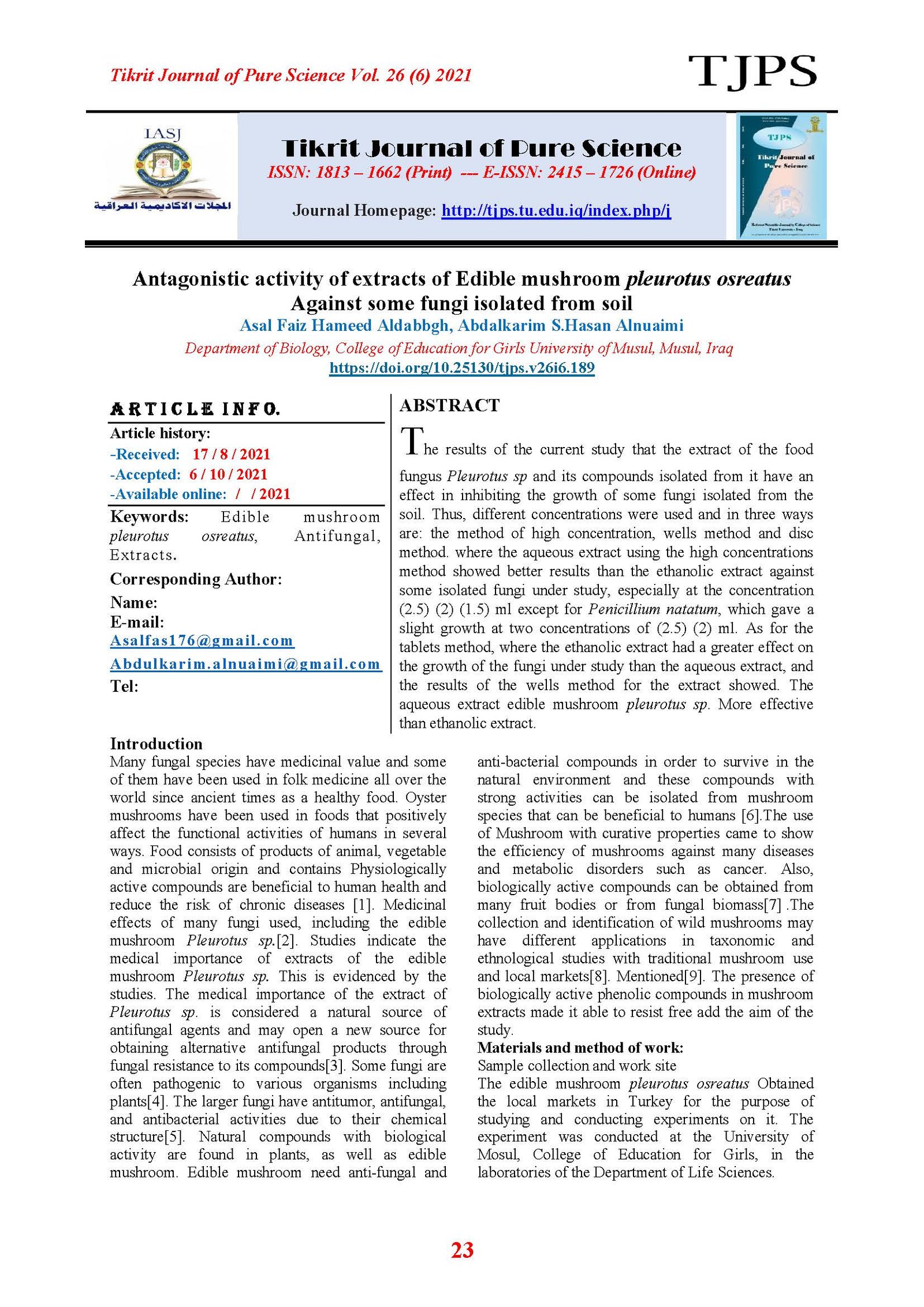Antagonistic activity of extracts of Edible mushroom pleurotus osreatus Against some fungi isolated from soil
Main Article Content
Abstract
The results of the current study that the extract of the food fungus Pleurotus sp and its compounds isolated from it have an effect in inhibiting the growth of some fungi isolated from the soil. Thus, different concentrations were used and in three ways are: the method of high concentration, wells method and disc method. where the aqueous extract using the high concentrations method showed better results than the ethanolic extract against some isolated fungi under study, especially at the concentration (2.5) (2) (1.5) ml except for Penicillium natatum, which gave a slight growth at two concentrations of (2.5) (2) ml. As for the tablets method, where the ethanolic extract had a greater effect on the growth of the fungi under study than the aqueous extract, and the results of the wells method for the extract showed. The aqueous extract edible mushroom pleurotus sp. More effective than ethanolic extract.
Article Details

This work is licensed under a Creative Commons Attribution 4.0 International License.
Tikrit Journal of Pure Science is licensed under the Creative Commons Attribution 4.0 International License, which allows users to copy, create extracts, abstracts, and new works from the article, alter and revise the article, and make commercial use of the article (including reuse and/or resale of the article by commercial entities), provided the user gives appropriate credit (with a link to the formal publication through the relevant DOI), provides a link to the license, indicates if changes were made, and the licensor is not represented as endorsing the use made of the work. The authors hold the copyright for their published work on the Tikrit J. Pure Sci. website, while Tikrit J. Pure Sci. is responsible for appreciate citation of their work, which is released under CC-BY-4.0, enabling the unrestricted use, distribution, and reproduction of an article in any medium, provided that the original work is properly cited.
References
[1] Patel Yashvant, Ram Navaian and V.K. Singh, 2012; Medicinal properties of pleurotus species (oyster Mushroom) World Journal of Fungal and plant Biology 3(1)., 2219-4312; 10.5829.
[2] Martínez-Carrera D. & López-Martínez de Alva L. (2010) Historia del cultivo comercial de hongos comestibles en México II: éxitos y fracasos durante el período 1991–2009. In: Hacia un Desarrollo Sostenible del Sistema de Producción-Consumo de los Hongos Comestibles y Medicinales en Latinoamérica: Avances y Perspecivas en el Siglo XXI. Martínez-Carrera D., Curvetto N., Sobal M., Morales P. and Mora V.M. Eds. pp. 513-551.
[3] Kumar Vinay and udit yadav, 2014.Scveening of anti fungal activity of pleurotus ostreatus and Agaricus bisporus. Biolife 2(3):918-923.
[4] Barros L, Calhelha RC, Vaz JA, Ferreria IC, Baptista P & Estevinho LM (2007). Antimicrobial activity and bioactive compounds of Portuguese wild edible mushrooms Methanolic extracts. Eur Food Res Technol 2: 151-156.
[5] Maria JA, Isabel CFR, Ferreira, Joana D, Vania T, Anabela M & Manuela P (2013). A Review on Antifungal Activity of Mushroom (Basidiomycetes) Extracts and Isolated Compounds. Curr Top Med Chem 21:49-50.
[6] Yamaç, M.; Bilgili, F. Antimicrobial activities of fruit bodies and/or mycelial 587 cultures of some mushroom isolates. Pharm. Biol., 2006, 44, 660-667.
[7] Poucheret, P.; Fons, F.; Rapior, S. Biological and pharmacological activity of higher 477 fungi: 20-Year retrospective analysis. My-cologie, 2006, 27,311-333.
[8] Kamalebo HM, Malale HNSW, Ndabaga CM, Degreef J, De Kesel A. 2018 – Uses and importance of wild fungi: traditional knowledge from the Tshopo province in the Democratic Republic of the Congo. Journai of Ethnobiology and Ethnomedicine 14, 13.
[9] Reis, G.C., F.B. Custódio, B.G. Botelho, L.R. Guidi and M.B.A. Gloria: Investigation of biologically active amines in some selected edible mushrooms.J.Food Compos. Anal 86, 103375 (2020).
[10] Al-Buni, Abdel-Aziz Muhammad, 1990, The Basics of Practical Fungi, first edition, Libya - Tripoli, Al-Fateh University.
[11] Ellis D., Stephen D., Helen A., Rosemary H. and Robyn B., 2007. Description of Medical Fungi, second edition; Australia, University of Adelaide.
[12] Le Grand, A. wondergem, P.A., Verpoor te, R and pousset, J.L., 1988. Anti- infectious phytotherapies, of the. Tree- Savannah of Senegal (west–Africa) II. Antimicrobail activity of 33 Species. Journal of ethnopharmacology. 22(1), 25-31. https://doi.org/10.1016/0378-8741(87)90122-x.
[13] Al-Numan, Adiba Younes Sharif Hammou (1998). Partial effect of some plant extracts on the growth and metabolism of a number of Gram-positive and Gram-negative bacteria, PhD thesis, College of Science, University of Mosul, Iraq.
[14] Al-Saadi, Hadi Alwan Muhammad, (2015). Comparison between the effect of garlic and bitter melon extracts and some antifungals on the growth of the two types of yeast Candida albicans and C. Tropicalis isolated from some patients in Diyala Governorate / Iraq, Tikrit University for Agricultural Sciences (15), (3).
[15] S. G. Jonathan, and I. O. Fasidi, 2003; Antimicrobial activities of two Nigerian edible macro fungal lycoperdon pusilum (Bat.EX) and lycoperdon giganteum; African journal of biomedical research, vio.6;85_90.
[16] Sridhar, Sekaran; Elumalai, Sivapra; Kasam, Ramalingim; Balakumar and Devendiran, Kavitha, 2011. Evaluation of Antibacterial and Anti fungal Activity of Ganoderma Lucidum (Curtis) P. karst Fruit Bodies Extracts.; World Journal of Science and Technology 1(6): 08_11.
